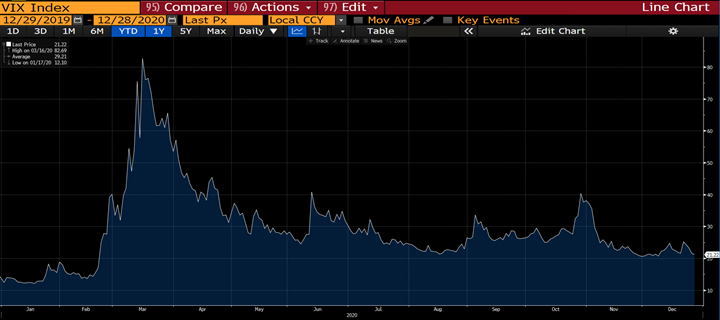You’re driving down the highway with a speed limit of 60 MPH. You’ve set cruise control to 67, the sweet spot where you probably won’t get pulled over, and if you did, the penalty may just be a slap on the wrist.
There’s no traffic, and you’ve zoned out listening to an informative podcast. Then, sirens and blue lights flashing behind you. Little did you know, you entered a town and the speed limit dropped to 35.
A ticket for 7 MPH over is one thing. A ticket for 32 MPH over is a horse of another color.
The ticket is 2 things:
1. A measure of the difference between what you thought to be real vs. what was actually real. Larger differences lead to larger prices.
2. The instrument used to splash reality in your face.
Maybe that’s a terrible analogy, but let‘s see it through…
Our team has put together what we think the future could hold. Be sure to read those pieces as they’re packed with information. In our eyes, this is the only way to manage money…through the windshield, not the rearview.
Vaccines, stimulus, economic reopenings, Fed support, etc. are leading towards a baseline consensus that seemingly points towards higher equity prices in 2021.
The consensus is the speed limit is 60 MPH. This is what we hope for, and believe the data is telling us. This is good, rising markets are welcomed! After all, who would buy bonds in this environment? From our perspective, the relative opportunity set for investors is still only stocks if you plan to generate a sufficient return.
What we have to prepare for is a 35 MPH reality. It’s this environment that could cause markets to stumble. We need to avoid commitments that disrupt our objective if this turns out to be the case.
It’s not about predicting, it’s about preparation.
To tie in the analogy above, the ticket (a measure and an instrument) acts in a similar way as volatility in the markets. When the markets dictate that what we thought to be the case just isn’t so, volatility will rise accordingly and prices will adjust. As Mark Twain said, “It ain’t what you don’t know that gets you into trouble. It’s what you know for sure that just ain’t so.”
You can think of each holding/decision we make as different vehicles running at different speeds. It’s our job to understand the cost of penalizing our decisions when volatility shows up. Nothing detrimental.
Here’s a real life example from 2020 – we harped about the environment for anything with excess yield and funky credit risk at the end of 2019 being priced to perfection. If there was any change in “speed limit”, we warned that these exposures could blow up – these vehicles were going too fast. We worked hard to avoid them like the plague, but as often happens the rearview mirror can be a trap. The allure of “the potential for strong performance, stable income, and low correlation” along with high yields was too compelling. Not to mention how well they had done in the past, when the speed limit remained consistent.
COVID changed the speed limit abruptly. Volatility exploded. The price their shareholders paid was steep. Drawdowns of 60% or more in some cases and the majority of these strategies remain far off the prices going into the COVID-induced volatility.
Our objective is to deliver portfolios and strategies prepared for both rising and falling markets. Alert for changes in the speed limit. Prepared, not perfect – big difference. We pursue this through volatility. Specifically, being long or owning volatility.
We want to have exposure that can profit from drastic speed limit changes. This is at the core of all that we do.

Source: Bloomberg as of 12.28.2020
Being Long Volatility
Volatility is a tool for portfolio construction and we own it – always. When you are “long” anything, that ownership benefits when prices rise. We are long volatility in a variety of ways. We own options on indices, individual stocks, and even the VIX itself. Exposures in our portfolio designed as benefactors of rising volatility.
We don’t own volatility to make predictions, we own it for the advantages gained at the portfolio level. We believe this constant ownership of volatility paves the way for simplicity – more stocks, less bonds.
We think bonds are ugly and we should own as few of them as possible. No, we don’t want to own liquid alternative crap or some other strategy with structural friction, we should just own stocks and let them be stocks. The ability to alter an allocation towards stocks and away from bonds changes everything.
With this shift, portfolios can have higher potential for return which directly reduces exposure to longevity risk. Yes, volatility risk gets most people’s attention, but it’s longevity risk in today’s environment that worries us. That’s the risk that sneaks up on you, only noticeable when it’s too late. What’s worse, dealing with short-term volatility or running out of money?
More stocks can improve returns, but can also increases volatility risk and drawdown to the portfolio. The way to make this shift and keep near term risks in check is…you guessed it, owning volatility.
If we are in a 35 MPH zone and don’t know it, reality can set in swiftly and bring discomfort with it. Markets correct quickly with a combination of rising volatility and dropping prices just about everywhere else.
It’s during these periods that ownership of volatility has the potential to work wonders towards mitigating drawdown AND creating cash to be deployed opportunistically. This positioning is a staple of our portfolios and our philosophy.
Are we prepared for really good outcomes? Are we prepared for really bad outcomes?
The speed limit is actually 60:
We’re optimistic. I can feel it in the office and in our conversations. We want nothing more than a rising, volatility-free market for 2021 and the stage may be set for that. If the market gives us a great 2021, allocations tilting towards stocks and away from bonds can improve the mix. We welcome a right-tailed 2021.
The speed limit is actually 35:
This does not scare us. The COVID selloff offered a good look at how effective this approach can be during market selloffs. We are consistent in owning volatility, that won’t change.
Built to Hold – Conclusion
We don’t claim to know the speed zone we’re in at the moment, or even the one we’re headed for, but we always prepare for change.
It’s the chance that we’ve zoned out and are unknowingly cruising too fast in a speed zone that we defend against. The ride from point A to point B matters. This philosophy facilitates an ability to deliver a ride that is easier to stick with, while addressing both drawdown and longevity risk.
This approach weathered the storm early in 2020, and participated like it should have for the remainder. When we think about 2021 and the relative opportunity set for investors, we couldn’t be more excited about the value and potential we offer. We won’t be perfect, but certainly prefer the simplicity and consistency of our process vs other alternatives.
Disclosures
Past performance is not indicative of future results. This material is not financial advice or an offer to sell any product. The information contained herein should not be considered a recommendation to purchase or sell any particular security. Forward looking statements cannot be guaranteed.
This commentary offers generalized research, not personalized investment advice. It is for informational purposes only and does not constitute a complete description of our investment services or performance. Nothing in this commentary should be interpreted to state or imply that past results are an indication of future investment returns. All investments involve risk and unless otherwise stated, are not guaranteed. Be sure to consult with an investment & tax professional before implementing any investment strategy. Investing involves risk. Principal loss is possible.
Advisory services offered through Aptus Capital Advisors, LLC, a Registered Investment Adviser registered with the Securities and Exchange Commission. Registration does not imply a certain level or skill or training. More information about the advisor, its investment strategies and objectives, is included in the firm’s Form ADV Part 2, which can be obtained, at no charge, by calling (251) 517-7198. Aptus Capital Advisors, LLC is headquartered in Fairhope, Alabama. ACA-2012-15.


